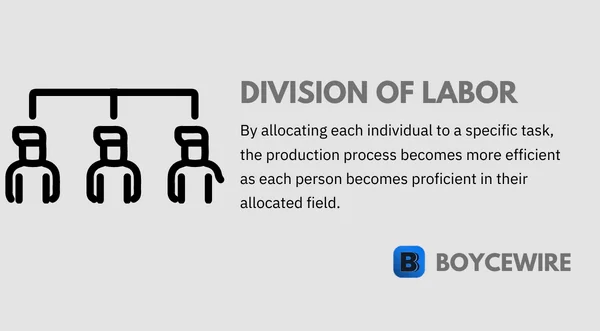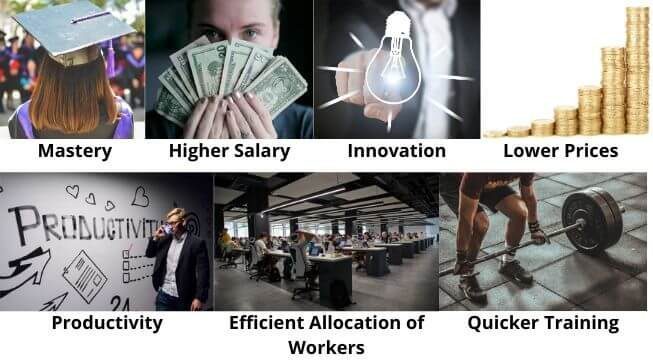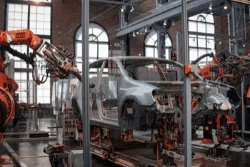Division of Labor: Pros, Cons & Examples

What is Division of Labor
The division of labor refers to the segmentation of tasks, with each person focusing on a specific part of the production process. Originally coined in 1776 by Adam Smith in his book ‘A Wealth of Nations’, he famously used a pin factory as an example. In it, he noted how there were many complex stages to the process.
First of all, someone has to draw the wire out, then straighten it, and then cut it. They then need to point it, and then grind the top of the head. In what is a relatively complex set of tasks, Smith highlighted the benefits of specialisation. This idea stems from the fact that each person needs to invest a set amount of time to become highly proficient in their role.
Key Points
- The division of labor is the process by which each part of production is split down into sectors by which an employee undertakes a specific task.
- Through the division of labor, production has become more efficient and we have seen significant economic and monetary gains.
- During a recession, people lose their jobs, businesses go bust, stock markets tumble, and exchange rates tend to decline.
It takes us time to learn the new version of Windows, a new language, or when we were younger: to read, write, and tie our shoelaces. So for each part of the pin-making process, it takes time to master. If each worker focused on a single task and mastered it, then the production process would be more efficient.
For instance, a pin manufacturer has 5 separate tasks to master, which makes the mastery process that much more time-consuming. That is before we consider the difficulties in trying to master 5 tasks at the same time. By focusing on one task, each individual is able to master it much quicker. In turn, by dividing the labor, it becomes easier to fill gaps in employment. So if the firm is short of a staff member, it is easy enough to train them up as they don’t need to be taught 5 different tasks.
Advantages of Division of Labor
The division of labor has spread across the developed world. We can see this in most consumer products today. For instance, the iPhone requires parts such as its case, battery, screen, and logic board. Not all of these are manufactured by Apple, let alone the same person. The firm requires separate companies with greater specialties. Among those include firms in Japan to manufacture the camera, German firms to produce the accelerometer, the US for its audio chip, and China for the battery and to assemble it.

There are many advantages to the division of labor, which is why is has become common place. So let us look at them below:
1. Efficient Mastery
Without the division of labor, mastery of a skill takes much longer. This is because a workers attention is spread across many areas.

For instance, it would be difficult to master a language if you are also trying to learn the piano, engineering, CSS, and economics. So, the division of labor allows the worker to focus and master a specific part of the process, which helps them learn it faster.
When a firm employs a new worker, it is far quicker to train them if they can focus on a specific task. For instance, an employee at a car manufacturing plant will be more efficient if they focused on fitting the wheels on, rather than the doors, the steering wheel, etc.
2. Quicker Training
Some industries have a higher turnover rate than others. The division of labor allows new employees to come in and easily replace lost workers. Instead of taking 12 months to become efficient in a role, it may take 3 months.

This reduces the impact of losing a worker. For instance, a worker that has learnt how to make a pin from start to finish also takes away their skills and expertise. To replace that worker will require months, if not years of training and experience.
By contrast, if a worker who makes the head of the pin leaves, an incoming employee has far less to learn and master. To put it another way; it is more efficient to replace a piece of the puzzle, than the entire puzzle.
3. Productivity
When workers focus solely on a specific task, they can master it quicker and more efficiently. In turn, workers become more productive.

By allowing workers pure focus on one task, their attentions are not diverted. If we go back to Smith’s pin factory example; the division of labor increased productivity from one pin per worker per day, to over 4,800 pins per worker per day (when dividing total output by number of workers).
The reason productivity increases is partially due to a greater level of mastery. However, it is also a by-product of several other advantages. For instance, it allows workers to flow to areas where they are best suited. Some employees may be better suited to dealing and manipulating data, whilst others are better at managing people and projects.
4. Efficient Allocation of Workers
When we say allocation of workers, we refer to their role within the production process. For instance, what may just be a one stage process could become a five-stage one. This creates five separate and unique roles, each with a different task.

If we look to large corporations, they have departments for finance, IT, human resources, and marketing, among others. The division of labor allows employees to specialise. This is efficient because those who are well suited to an IT role will not be so well suited to a human resources role.
There are specific skills that are not necessarily well transferred to specific tasks. So rather than be a jack of all trades and master on none; division of labor allows the employee to be a master.
5. Cheaper Products
As division of labor increases productivity, it also means that it’s cheaper to produce a good. In turn, this translates to cheaper products.

If labor is divided between five people who specialise in their task, it becomes quicker and more efficient. In turn, the number of goods produced increases. For instance, it is far more difficult for a server at McDonalds to serve customers, cook the burgers, and fry the fries, than purely serve the customer.
So when the server focuses on the customer, it leads to better customer service, and a more efficient process.
6. Higher Wages
It must be said that not all the productivity gains are necessarily passed on to the consumer. A proportion may go to profits, whilst some may go to higher pay for employees.

Employees may often consider this as an option to reduce the negative impacts. For instance, some workers may become demotivated and bored by some repetitive aspects of the job. Higher salaries can help to reduce the effect, although may not eliminate it completely.
This is what Henry Ford did when he created the Ford assembly line in the early 20th Century. Although workers were set specific and repetitive jobs, they were paid higher than the industry average. What happened was, the turnover rate declined, and workers became happier.
7. Innovation

When workers are set specific tasks, that is their pure focus. So it becomes easier to see pitfalls in the existing process. Doing the same task each day makes it easier to analyse areas for improvement. It takes up more of the brains processing power, so it is at the forefront of a workers mind.
Disadvantages of Division of Labor
The division of labor largely brings a number of significant advantages. However, there are several disadvantages that need to be considered. Although the advantages are still overwhelming, it is still important to identify the disadvantages and how to mitigate them.
1. Boredom from Repetition

Specialising on a specific task can increase productivity, but it can introduce a level of monotony and boredom. Doing the same thing repeatedly without any challenge is not conductive to the human condition. We naturally crave advancement and meaning.
Certain jobs are more monotonous than others. Think of standing in the middle of a factory, repetitively putting goods in a box. Some may enjoy such tasks, whilst others become disengaged. However, on the whole, productivity may decline and turnover rates increase. Yet compared to the pre-division of labor, the productivity rates are still at advanced levels.
One of the ways by which employers counter-act boredom is either through performance based bonuses, higher pay, or performance checks. The success of which depends on how and where they are implemented.
2. Interdependence
When tasks are split down between different departments/employees, a level of interdependence is created. For instance, the creation of a simple pencil is split down into several parts. Someone must mine the granite, another to cut the wood, another to produce the rubber, and another to put it all together.
Nobody in the process truly understands how the pencil is made, but all are involved in its creation. At the same time, the final production is reliant on the timely delivery of materials. Should one part of the process be delayed, either by a strike or natural disaster, the whole chain can fall apart.
3. Lack of Responsibility
When each person is only a small part of a bigger chain, it can become difficult to assign responsibility. If a task fails, it can be time-consuming to find out where things went wrong. At the same time, it also becomes easier for certain individuals to slack.
When one person produces X output, it is easily measurable. However, when they are part of a bigger process, it is difficult to measure the final output. As a result, some employees may not take so much responsibility for the failure of tasks.
4. Loss of Craftsmanship

In traditional systems of production, a craftsman would take pride in seeing a product through from start to finish. With the division of labor, workers only see a small part of the production process, which can lead to a loss of pride and craftsmanship.
5. Over-specialization
While specialization can lead to increased efficiency and proficiency in a certain task, it can also lead to over-specialization. This can make it hard for workers to adapt to new tasks or job roles, making them less flexible and potentially at risk in case of changes in the market demand or technology.
Division of Labor Examples
1. Assembly Line
Perhaps one of the most famous examples of the division of labor was the creation of the assembly line by Henry Ford in 1913. The Ford Model T was previously manufactured with parts over the floor with an employee putting it together. Like building a flatpack from Ikea!
What Ford did was divide the process up into 84 distinct steps, training an employee in one specific task.

So one employee would put the bolts on the wheel, another the steering wheel, another the gear stick, so on and so forth. As a result, the product time of a Ford Model T decreased from 12 hours to just 90 minutes. Ford Model T decreased from 12 hours to just 90 minutes.
In turn, such efficiencies allowed Ford to reduce prices from $850 to less than $300. In 2019 prices, that would be a reduction from $21,000 to $9,000.
2. Big Business
Big businesses tend to have several different departments that specialise in a specific area. For instance, there are finance departments, marketing departments, HR departments etc.
Without the division of labor, businesses would be unable to achieve the scalability they do today. Just imagine the Walmart CEO stacking shelves, serving customers as well as making investment decisions.
3. House Building

On a construction site, different workers perform different tasks based on their skills and expertise. Architects design the structure, bricklayers lay the bricks, electricians handle the wiring, and painters do the painting. This division of labor ensures that each task is performed by a specialist, resulting in high-quality work.
4. Education
Even in academic institutions, the division of labor is clear. Professors teach and conduct research, administrators manage the operations and finances, librarians manage the library, and janitors keep the premises clean.
5. Hospitals

Hospitals also have a clear division of labor. Surgeons perform operations, nurses provide care to patients, pharmacists manage medications, and administrative staff coordinate scheduling and billing. Each role is vital for the hospital to function effectively.
6. Restaurants
In restaurants, there is a clear division of labor. Chefs cook the food, waitstaff serve the food, dishwashers clean the dishes, and bartenders prepare drinks. Each person has their specific role that contributes to the overall functioning of the restaurant.
FAQs
The division of labor refers to the segmentation of tasks, so each person focuses on a specific part of the production process.
Some examples of division of labor can be found everywhere. Here are a few examples
1) The assembly line – the product gets transferred down an automated line where people add components to assist with making the final product.
2) Apple – it has a different manufacturer for almost all of its different parts, from the ID sensor to the camera.
3) House Building – a separate worker is required for the plumbing, landscaping, construction, electric work, and plastering.
The term division of labor was originally coined by Adam Smith in his 1776 publication ‘A Wealth of Nations’.
Division of labor can increase productivity by allowing workers to specialize in one task and become more skilled and efficient, leading to faster production and higher output.
A company can successfully implement division of labor by carefully selecting tasks to be divided, training workers to specialize in specific tasks, and continuously monitoring and evaluating the process to ensure maximum efficiency and productivity.
About Paul
Paul Boyce is an economics editor with over 10 years experience in the industry. Currently working as a consultant within the financial services sector, Paul is the CEO and chief editor of BoyceWire. He has written publications for FEE, the Mises Institute, and many others.

Further Reading
 Scarcity: What it is in Economics, Examples & Causes - Scarcity refers to the limit upon resources that we have which force economical decision making.
Scarcity: What it is in Economics, Examples & Causes - Scarcity refers to the limit upon resources that we have which force economical decision making.  Why Free Markets are Important - According to the Collins Dictionary, a free market is an economic system that allows supply and demand to regulate prices,…
Why Free Markets are Important - According to the Collins Dictionary, a free market is an economic system that allows supply and demand to regulate prices,…  Enron Scandal - The Enron scandal refers to a major corporate fraud involving the energy company Enron Corporation, characterized by deceptive accounting practices…
Enron Scandal - The Enron scandal refers to a major corporate fraud involving the energy company Enron Corporation, characterized by deceptive accounting practices… 